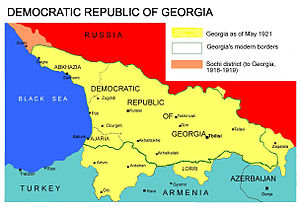
Back الحرب الجورجية الأرمنية Arabic Gürcüstan–Ermənistan müharibəsi Azerbaijani Армяна-грузінская вайна Byelorussian Arménsko-gruzínská válka Czech Kartvela-armena Milito (1918) Esperanto Guerra georgiano-armenia Spanish جنگ گرجستان و ارمنستان Persian Guerre arméno-géorgienne French מלחמת גאורגיה–ארמניה HE Հայ-վրացական պատերազմ Armenian
| Armeno-Georgian War | |||||||||
|---|---|---|---|---|---|---|---|---|---|
| Part of the aftermath of World War I | |||||||||
 | |||||||||
| |||||||||
| Belligerents | |||||||||
|
|
| ||||||||
| Commanders and leaders | |||||||||
| Drastamat Kanayan |
Giorgi Mazniashvili Varden Tsulukidze | ||||||||
| Strength | |||||||||
|
In Lori: 12 infantry companies at Sadakhlo[4] |
In Lori: Fewer, two armoured trains In Georgia proper: Two infantry regiments[2] 1,000 troops and 1 armoured train at Sadakhlo[2] 3,500 troops at Shulaveri[4] | ||||||||
| Casualties and losses | |||||||||
|
Heavy[5] Less than 100 taken prisoner (Hovannisian[1]) |
Heavy[5] About 1,000 taken prisoner (Hovannisian[1]) | ||||||||

The Armeno-Georgian War was a short border dispute that was fought in December 1918 between the newly independent Democratic Republic of Georgia and the First Republic of Armenia, largely over the control of former districts of the Tiflis Governorate, in Borchaly (Lori) and Akhalkalaki.
In May 1918, towards the end of World War I, Armenia and Georgia both declared their independence, dissolving the short-lived union between them. Both Georgia and Armenia claimed Lori and Akhalkalaki, both of which were populated primarily by Armenians. The border dispute turned into an open military conflict on 7 December 1918. Armenian forces initiated coup de mains that brought them within 10 kilometers of the Georgian capital, Tiflis, before Georgian troops were able to organize counterattacks. Allied intervention forced a ceasefire. Battles continued until the ceasefire came into effect at midnight on December 31.[6]
A neutral zone, under Allied supervision, was declared in the Borchaly district, which would later be split in between the two states.[7] The large Armenian population of Tiflis and other Georgian-controlled regions was subject to mass arrests and other forms of persecution both during and after the war.[8][9] Armenia did not succeed in the nearly-obtained original goal of gaining land up to the Khrami River, and the entire war took place on land that had been controlled prior by Georgia.[10] The result of the war is considered inconclusive, with the Armenian side declaring a successful liberation of Armenian territories and the Georgian side declaring a successful defense against an invasion.[1]
- ^ a b c d Hovannisian 1971, p. 119.
- ^ a b c Hovannisian 1971, p. 113.
- ^ Hovannisian 1971, pp. 111, 118.
- ^ a b Hovannisian 1971, p. 118.
- ^ a b Hovannisian 1971, pp. 111–119.
- ^ Hovannisian 1971, p. 114.
- ^ Hovannisian 1971, pp. 121, 122.
- ^ Chalabian 2009, p. 118.
- ^ Hovannisian 1971, p. 122.
- ^ Hovannisian 1971, p. 111.
© MMXXIII Rich X Search. We shall prevail. All rights reserved. Rich X Search